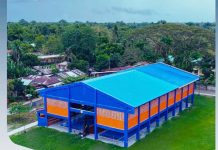TACLOBAN CITY- The United Nations High Commissioner for Refugees (UNHCR) started distributing on October 13 thousands of core relief items to priority areas in this city as part of its on-going recovery assistance.
The UN refugee agency began its distribution of 4,000 hygiene kits comprised of toiletries, wrap-around clothing and undergarments in four transitional shelters in the north of the city where 372 displaced families from the hardest-hit communities of the San Jose district are temporarily relocated. The hygiene kits will be apportioned across the agency’s sub-offices in Ormoc City in Leyte and Guiuan, Eastern Samar for subsequent distribution in the coming days. The delivery of these core relief items from the UNHCR is primarily linked to their global protection mandate in situations of displacement resulting from conflict and natural disasters. “These hygiene kits help improve the water and sanitation conditions for displaced families in their new and temporary relocation sites by mitigating risks of certain diseases,” said Eilish Hurley, UNHCR associate protection officer in Tacloban.
Earlier this year, the UNHCR completed its distribution of emergency core relief items such as tents, plastic sheets, blankets, jerry cans, kitchen sets, solar lanterns and other essential non-food items across three regions in the central Philippines. “To date, and since November last year, we have delivered core relief items to more than 700,000 of the most vulnerable of the affected populations including those in far-flung areas,” Hurley added. Meanwhile, the International Organisation for Migration (IOM) coordinated with UNHCR’s protection team to bring their energy-efficient charcoal-fueled stoves to these priority areas.
The UNHCR is also set to distribute another batch of solar-powered lanterns later this year. Solar lanterns are regarded as one of the most innovative relief items in the agency’s operations, lighting up communities to help the safety and security of families. UNHCR’s emergency and recovery efforts are part of an inter-agency humanitarian response to typhoon Haiyan in coordination with government authorities and local communities. (PR)



